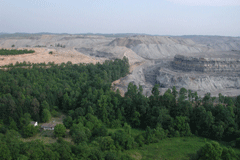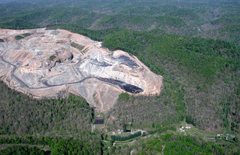EPA Eyes Mountaintop Removal Mining
Air Date: Week of March 27, 2009

A mountaintop removal coal mine in West Virginia's Boone and Lincoln counties encroaches upon a home. (Photo: Vivian Stockman Vivian www.ohvec.org)
The Environmental Protection Agency has expressed concern that mining practices routinely approved by the Bush administration may seriously damage water quality. Environmentalists hoped this would lead to a moratorium on mountaintop removal but the EPA says it is merely examining permit applications more closely. Host Bruce Gellerman talks with Ken Ward, a reporter for the Charleston Gazette in West Virginia.
Transcript
GELLERMAN: It’s Living on Earth, I’m Bruce Gellerman.
Valley fill is the debris that’s dumped into rivers and streams from a method of extracting coal called “mountaintop removal”. It’s done largely in Kentucky and West Virginia, and it’s at the center of an intense political, legal, and scientific debate.
When the EPA recently announced it was going to review two mountain top removal permits, environmental groups cheered. Then, the very next day, when the agency issued a clarification, they jeered.
Ken Ward is a staff reporter with The Charleston Gazette in West Virginia. His blog, “Coal Tattoo” chronicles the EPA controversy with the headline “EPA on Mountaintop Removal: What’s It All Mean?”
So, Ken Ward, what does it all mean?
WARD: [Laughs] Well, we don’t know yet, and I think that’s an important point for everyone to remember. What’s happened here is the Obama administration has begun an initiative where the staff at the Environmental Protection Agency are going to take a more active role in reviewing Clean Water Act permits for valley fills that are being issued by the Army Corps of Engineers. And, judging from the actions the EPA took on two permits, one in Kentucky and one in West Virginia, it’s kind of difficult to tell exactly where EPA is headed. But it’s very clear that they’re interested in the science that indicates that these mountain top removal mines are damaging the environment, and they want to do something to rein them in
GELLERMAN: Well, everybody jumped on it. I gotta tell you, you know, the Sierra Club, one of the directors there hailed it as a “new day for the EPA.” And then people for the Mining Association said you know, “hey, we’re talking about 77,000 jobs here.”

(Photo: Vivian Stockman, www.ohvec.org)
WARD: Well sure and I think its correct that in some ways it is a new day, because this is part of EPA’s job. The EPA is supposed to review these permits that the Corps is considering and determine whether or not, in EPA’s best judgment, they comply with the Clean Water Act. And for the last eight years under the Bush administration, those permits pretty much got a free pass, and unless environmentalists went to a federal judge and tried to do something about it. On the other hand there were some kind of unfortunate reports in the media, and most egregiously in blogs and press releases, from both the industry and from environmental advocates, which said that EPA had issued a moratorium or was halting these permits, and that’s just not what EPA did. And for some reason the folks at EPA felt compelled to issue a follow up press release saying that “oh, no, no, no, we’re not blocking any permits and we’re just reviewing them.” And really it wasn’t a change in EPA’s position. It was EPA trying to clarify some mischaracterizations that were out there about what EPA was doing.
GELLERMAN: So Ken, let’s talk about mountain top removal, really the core of the issue here – it’s really controversial. What is it?
WARD: In mountain top removal, mine operators take explosives and they literally blast the top off of mountains to expose low sulfur coal seams. And they remove the coal and then the stuff that’s left over, the rock and dirt, the stuff that used to be the mountain, they shove into the closest valley, burying whatever streams and life and forest happens to be there.
GELLERMAN: And that’s where the EPA’s interest come into play here. They’re concerned about the water quality of those streams that got waste dumped on them.
WARD: The EPA’s concerned about the water quality of the streams that are being buried and they’re also concerned about the emerging science showing that these valley fills are damaging water quality down stream from where the fills are. And they’re also concerned, under the National Environmental Policy Act, about broader environmental implications – the loss of rare forests, the damage to endangered species. And folks who live here in Appalachia, where most of this is done, are very concerned about the damage to the mountain culture and blasting and water quality and things like that that are bothersome and troublesome to people who live near these operations.
GELLERMAN: It was the specter of the EPA saying, hey maybe we’ll go after all these permits that really raised the industry’s ire.
WARD: Uh, yes. But it’s important to note that EPA never said the word moratorium. They never said the word hold. They never said the word halt. And, in fact, they haven’t halted any permits. All that the EPA has done is objected to the Corps issuing two specific permits, one in West Virginia, one Kentucky, and called for more and more detailed review of those. And Lisa Jackson has said that EPA will review all of these permits.

A mountaintop removal coal mine in West Virginia's Boone and Lincoln counties encroaches upon a home. (Photo: Vivian Stockman www.ohvec.org)
GELLERMAN: Well we’re talking about coal mining, but it seems to me, as you’re talking, that really what we’re discussing is a political minefield.
WARD: It is a political minefield. You know, Governor Joe Manchin here in West Virginia, immediately announced that he had asked for and has got a meeting with some folks at the White House to talk about this. The Coal Association and National Mining Association are putting out press releases, throwing out all sorts of wild numbers about how many jobs this is going to cost. And what’s really kind of unfortunate about all of that is that there seems to be an utter unwillingness by political leaders in this region and by the coal industry to have a reasonable conversation – and, in fact, by some in the environmental community – to have a reasonable conversation about how much damage is this practice doing? Is this something we should continue? And, if not, what else can we do? How much of this coal can be mined by underground mining methods. What other sorts of jobs can this region have. I wrote a post on our “Coal Tattoo” blog about the Obama administration’s proposal to increase the spending in Appalachia to clean up abandoned coalmines. And now the same sorts of guys that are out running bull dozers and heavy equipment in strip mines and are mining coal, they can do the same kind of work reclaiming abandoned mines. And it seems like that would be an economic boon for this region. But neither side seems to be focusing on that.
GELLERMAN: Ken Ward, is a staff reporter for the Charleston Gazette in West Virginia. His blog is called “Coal Tattoo.”
Well, Ken, thanks a lot.
WARD: Great, thank you.
Links
Ken Ward's blog, Coal Tattoo, for the Charleston Gazette in West Virginia
Living on Earth wants to hear from you!
Living on Earth
62 Calef Highway, Suite 212
Lee, NH 03861
Telephone: 617-287-4121
E-mail: comments@loe.org
Newsletter [Click here]
Donate to Living on Earth!
Living on Earth is an independent media program and relies entirely on contributions from listeners and institutions supporting public service. Please donate now to preserve an independent environmental voice.
NewsletterLiving on Earth offers a weekly delivery of the show's rundown to your mailbox. Sign up for our newsletter today!
 Sailors For The Sea: Be the change you want to sea.
Sailors For The Sea: Be the change you want to sea.
 The Grantham Foundation for the Protection of the Environment: Committed to protecting and improving the health of the global environment.
The Grantham Foundation for the Protection of the Environment: Committed to protecting and improving the health of the global environment.
 Contribute to Living on Earth and receive, as our gift to you, an archival print of one of Mark Seth Lender's extraordinary wildlife photographs. Follow the link to see Mark's current collection of photographs.
Contribute to Living on Earth and receive, as our gift to you, an archival print of one of Mark Seth Lender's extraordinary wildlife photographs. Follow the link to see Mark's current collection of photographs.
 Buy a signed copy of Mark Seth Lender's book Smeagull the Seagull & support Living on Earth
Buy a signed copy of Mark Seth Lender's book Smeagull the Seagull & support Living on Earth

